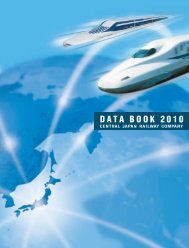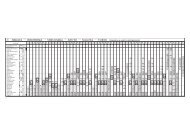CENTRAL JAPAN RAILWAY COMPANY Annual Report 2007
CENTRAL JAPAN RAILWAY COMPANY Annual Report 2007
CENTRAL JAPAN RAILWAY COMPANY Annual Report 2007
You also want an ePaper? Increase the reach of your titles
YUMPU automatically turns print PDFs into web optimized ePapers that Google loves.
Conventional Railway<br />
JR Central operates a network of 12 conventional lines, which form an<br />
integrated network with the Tokaido Shinkansen. These lines have contributed<br />
substantially to the development of communities and the regional economy<br />
around Nagoya and Shizuoka areas.<br />
Daily Departures<br />
Local Trains (Trains / day)<br />
<br />
<br />
<br />
<br />
During FY<strong>2007</strong>.3, while ridership on local trains showed good trends due to the<br />
introduction of newly manufactured rolling stock and timetable revisions, express train<br />
ridership dropped comparatively from the year before due to the absence of the Expo<br />
2005 Aichi. As a result, passenger kilometers dropped 0,6% year-on-year to 9.046<br />
billion passenger kilometers and railway operation revenues dropped 1.7% year-on-year<br />
to ¥103.9 billion.<br />
Meanwhile, in the Spring of <strong>2007</strong>, “Noda-shimmmachi” station was opened in between<br />
Higashi-Kariya station and Kariya station on the Tokaido Line and service between<br />
Tsunogawa and Inotani Station on the Takayama Line, which had been offered by buses<br />
after train service was interrupted by a typhoon in 2004, should be restored and in<br />
operation by September <strong>2007</strong>.<br />
Improvement of Service on Conventional Railway<br />
In regards to JR Central’s conventional railway network, we are surely and steadily<br />
improving services such as introducing faster and more modern rolling stock, increasing<br />
the frequency of trains, and the installation of air conditioning on all trains.<br />
One measure that has proved especially popular is the introduction of “Wide View”<br />
rolling stock on limited express trains. We have synchronized the timetables of both<br />
Tokaido Shinkansen and conventional lines limited express to create an integrated<br />
network of the Tokaido Shinkansen and Wide View trains. In terms of conventional trains ,<br />
we are making efforts to increase frequency of local commuter trains during peakdemand<br />
morning and evening periods and introduce expanded rapid-train services that<br />
reduce travel times. Moreover, train intervals are being adjusted to realize equally spaced<br />
departures, in order to provide timetables that better serve passenger needs.<br />
FY 2006 Timetable Revision<br />
During FY<strong>2007</strong>.3, along with surely and steadily introducing and new manufactured<br />
Series 313 rolling stock, the timetable for the Nagoya region was revised in October 2006<br />
thereby improving our transportation system, which included increasing the number of<br />
rapid train services on the Tokaido Line. Furthermore, the timetable for the Shizuoka<br />
region was revised by, for example, changing operation patterns in conjunction with<br />
ridership in March <strong>2007</strong>.<br />
<br />
<br />
<br />
<br />
<br />
<br />
Express Trains (Trains / day)<br />
<br />
<br />
<br />
<br />
<br />
Note: Departures shown are as of the beginning of each month,<br />
and exclude extra trains<br />
Conventional Railway Ridership (million passengers)<br />
<br />
<br />
Total<br />
Commuter<br />
Passes<br />
<br />
<br />
Ordinary Tickets<br />
<br />
<br />
<br />
<br />
<br />
<br />
<br />
<br />
<br />
<br />
<br />
<br />
<br />
<br />
<br />
<br />
<br />
<br />
<br />
<br />
<br />
<br />
<br />
Takayama Line’s Restoration Work<br />
17





